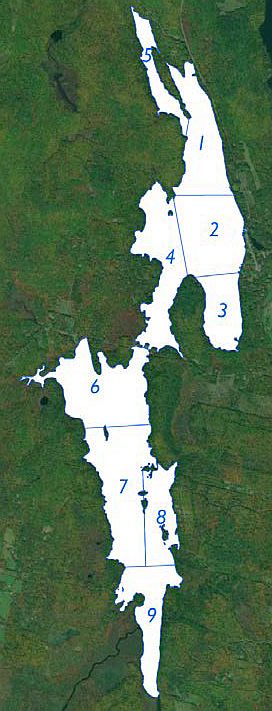Counting Loons
by Pete Kallin

Fred Knight, loon count assistant
The third Saturday in July is the annual loon count in Maine, coordinated by Maine Audubon. This year's count took place July 17. It was the 38th annual count in this important ongoing citizen-science project dedicated to better understanding one of Maine's most iconic birds.
Every year over 1000 volunteers, of which I am one, attempt to count all the loons on over 300 Maine lakes at the same time. It's organized like a military operation, and I am the coordinator for the dozen or so volunteers on Long Pond, which is divided into nine survey areas, with a tenth in Ingham Pond.

Long Pond loon survey areas
Early in the morning all counters head for their assigned section of the lake to be in position to count all the adult loons and loon chicks in their area between 7:00 a.m. and 7:30 a.m. I left my dock around 6 a.m., planning to fish for a bit before picking up my counting partner, Fred Knight, at his dock on the way to our survey area. It was overcast but with practically no wind, almost perfect conditions for spotting loons.
Our assigned area was a cove that has been used for many years by a pair of loons that typically nests on a secluded beach on a small peninsula. For several years, this pair was unsuccessful in raising very many chicks, because land-based and avian predators found the nest and ate the loon eggs before they hatched.
Two years ago, the Belgrade Lakes Association, as part of their ongoing study of loons on Great and Long Pond, built and installed a floating raft nest with an avian guard to prevent predation by eagles, ravens, and blue herons. (See this article by Dick Greenan.) The nest was moored about 20-feet offshore from the usual nesting site to provide the loons some protection from terrestrial predators such as racoons, minks, et al. When land-based predators have to cross water to reach the nest, the defensive advantage shifts strongly in the loons favor!

Tim and daughter Doina having a great time on Great Pond.
For the second year in a row, the loons successfully used this nest and on the morning of the count, there were two brand new loon chicks in the cove. As of press time, I had not received results from all of my counters, but it appears likely that both adult and chick numbers are up somewhat from last year (2020 Long Pond, including Ingham: 38 adults, 3 chicks). Already 5 chicks have been reported.
I also got a little hiking in and some foraging for raspberries and mushrooms, which are becoming more common after the recent rains. As the summer progresses and COVID pandemic restrictions continue to ease, more and more visitors are returning to our area. A young family from CT recently decided to "take it outside." Mom, dad, son, and daughter went fishing with Mike Guarino on Great Pond. They had a great time, as daughter, Doina caught her first bass. Her smile is almost as big as her fish!

King of the Mountain: Grandson Bayard stands on top of a boulder during an early morning hike with his mom on The Mountain.
Recently my daughter took my youngest grandson on a hike up The Mountain, where he practiced his "bouldering" skills, getting ready for the 2032 Olympics, which will take place in Australia! These young families are definitely in the "Take it Outside" mode for their vacations and helping to make memories that will last a lifetime for their young children.
Take advantage of the rest of the summer and get out on the lakes or hike or bike in the hills. And take a kid along. You will be creating memories that will last. Check out the events at the 7-LA website and the sign in front of the Maine Lakes Resource Center. Events are being presented as conditions allow and the schedule is fluid.
<— Previous Article • Summaries • Next Article —>
©2021 by Summertime in the Belgrades. All rights reserved.

